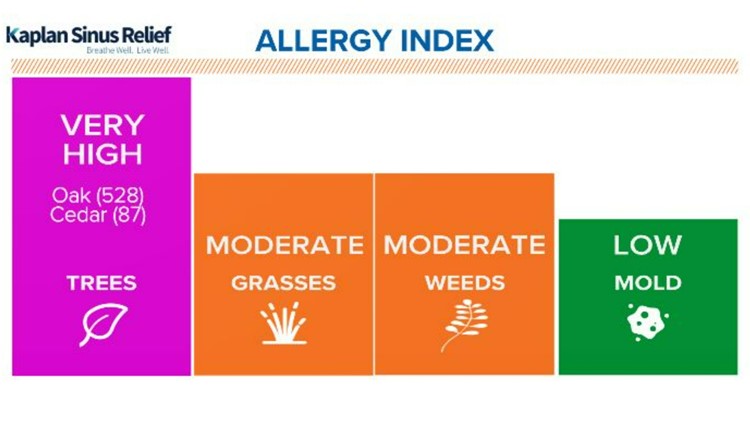HOUSTON — Oak pollen has come down a little from the pollen count recorded last week, but the tree pollen levels remain very high on Tuesday, according to KHOU 11 Meteorologist Chita Craft.
Now, grass and ragweed pollen are starting to climb and are reaching moderate levels, Luckily, mold remains low.
Keep taking those allergy meds, friends.
Is pollen bad in Houston right now?
The pollen count taken on Monday showed oak pollen at heavy levels while cedar, pine, maple, and ash pollen were at medium levels, according to the Houston Health Department.


What do the pollen count numbers mean?
The Houston Health Department says the following ranges are based on the data reported by all counting stations for weeds, grasses, trees and mold according to the National Allergy Bureau.
Weed pollen is measured per cubic meter of air.
- 1-9 pollen per cubic meter of air or less = Low
- 10 to 49 = Medium
- 50 to 499 = Heavy
- Greater than 500 = Extremely Heavy
Grass pollen is measured per cubic meter of air.
- 1-4 pollen per cubic meter of air or less = Low
- 5 to 19 = Medium
- 20 to 199 = Heavy
- Greater than 200 = Extremely Heavy
Tree pollen is measured during the tree pollen season of mid-January through mid-April. Cedar Elm tree pollen is measured in September and October. All tree pollen types are reported by the health department's laboratory.
- 1 to 14 pollen per cubic meter of air = Low
- 15 to 89 = Medium
- 90 to 1499 = Heavy
- Greater than 1500 = Extremely Heavy
Mold spores are measured per cubic meter of air.
- 1 to 6499 = Low
- 6500 to 12999 = Medium
- 13000 to 49999 = Heavy
- Over 50000 = Extremely Heavy
How to control allergens indoors
The Environmental Protection Agency says the three ways to improve your indoor air quality are to:
- Control contact with indoor airborne allergens
- Ventilate indoors area well
- Use air cleaners to clean indoor air
According to the Asthma and Allergy Foundation of America, you can control indoor allergens by cleaning and reducing allergens in your home. The main sources of indoor allergens are:
- Pets
- Wall-to-wall carpet
- Soft furniture
- Stuffed toys
- Bedding
- Damp areas
- Indoor plants
- Mattresses that aren’t in allergy covers
- Pillows and bedding you can’t wash in hot water
Here are the steps to control allergens indoors from the Asthma and Allergy Foundation of America:
Control dust mites: Keep surfaces in your home clean and uncluttered. Bare floors and walls are best, especially in the bedroom. Avoid wall-to-wall carpet if you can. Also, avoid heavy drapes and overstuffed fabric furniture. Replace drapes and blinds with roll-down shades or washable curtains.
Vacuum once or twice a week: Vacuuming helps keep allergens low. But poor quality vacuums could put dust into the air. Use one that is certified allergy friendly.
Prevent pet dander: People with pet allergies are allergic to animal dander which are shed skin cells that all animals have. Long-haired pets can also bring pollen inside in high pollen seasons like spring and fall.
Keep windows and doors closed: Use air conditioning in warm weather to control dust mites and reduce humidity. Change filters often.
Avoid mold spores: Reduce moisture around the bathroom, kitchen, and other areas where there is a lot of water. Consider using dehumidifiers to reduce both mold and dust mites.
Control cockroaches: Cockroaches can cause allergic reactions in people. Use poison baits, boric acid, and traps instead of chemicals. Chemicals may irritate your sinuses and asthma.


